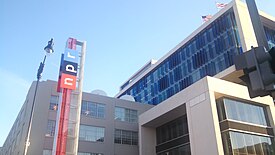
Northwest is the northwestern quadrant of Washington, D.C., the capital of the United States, and is located north of the National Mall and west of North Capitol Street. It is the largest of the four quadrants of the city, and it includes the central business district, the Federal Triangle, and the museums along the northern side of the National Mall, as well as many of the District's historic neighborhoods.
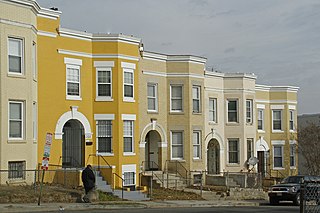
Eckington is a neighborhood in Northeast Washington, D.C., located south of the Prospect Hill and Glenwood Cemeteries. Eckington is less than one mile (1.6 km) southeast of Howard University and exactly one mile north of the United States Capitol. Eckington is also the home of the District of Columbia office of Sirius XM Radio.
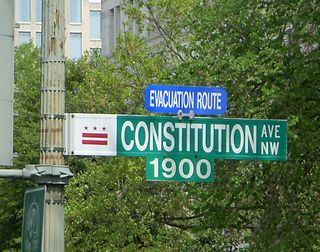
Constitution Avenue is a major east–west street in the northwest and northeast quadrants of the city of Washington, D.C., in the United States. It was originally known as B Street, and its western section was greatly lengthened and widened between 1925 and 1933. It received its current name on February 26, 1931, though it was almost named Jefferson Avenue in honor of Thomas Jefferson.

There are many outdoor sculptures in Washington, D.C. In addition to the capital's most famous monuments and memorials, many figures recognized as national heroes have been posthumously awarded with his or her own statue in a park or public square. Some figures appear on several statues: Abraham Lincoln, for example, has at least three likenesses, including those at the Lincoln Memorial, in Lincoln Park, and the old Superior Court of the District of Columbia. A number of international figures, such as Mohandas Gandhi, have also been immortalized with statues. The Statue of Freedom is a 19½-foot tall allegorical statue that rests atop the United States Capitol dome.
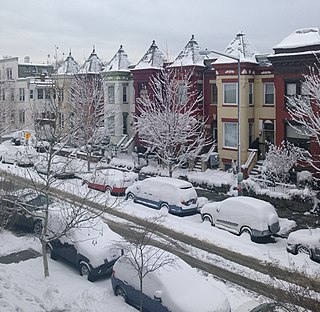
Bloomingdale is a neighborhood in the Northwest quadrant of Washington, D.C., less than two miles (3 km) north of the United States Capitol building. It is a primarily residential neighborhood, with a small commercial center near the intersection of Rhode Island Avenue and First Street NW featuring bars, restaurants, and food markets.

Massachusetts Avenue is a major diagonal transverse road in Washington, D.C., and the Massachusetts Avenue Historic District is a historic district that includes part of it.

Independence Avenue is a major east-west street in the southwest and southeast quadrants of the city of Washington, D.C., in the United States, running just south of the United States Capitol. Originally named South B Street, Independence Avenue SW was constructed between 1791 and 1823. Independence Avenue SE was constructed in pieces as residential development occurred east of the United States Capitol and east of the Anacostia River. Independence Avenue SW received its current name after Congress renamed the street in legislation approved on April 13, 1934. Independence Avenue SW originally had its western terminus at 14th Street SW, but was extended west to Ohio Drive SW between 1941 and 1942. The government of the District of Columbia renamed the portion of the road in the southeast quadrant of the city in 1950.

Streetcars in Washington, D.C. transported people across the city and region from 1862 until 1962.

Florida Avenue is a major street in Washington, D.C. It was originally named Boundary Street, because it formed the northern boundary of the Federal City under the 1791 L'Enfant Plan. With the growth of the city beyond its original borders, Boundary Street was renamed Florida Avenue in 1890.

Fort Totten is a neighborhood located in Ward 5 of Northeast Washington, D.C.

Truxton Circle, sometimes known as East Shaw, is a neighborhood of Washington, D.C., located in Northwest D.C.

Barney Circle is a small residential neighborhood located between the west bank of the Anacostia River and the eastern edge of Capitol Hill in southeast Washington, D.C., in the United States. The neighborhood is characterized by its sense of community, activism, walkability, and historic feel. The neighborhood's name derives from the eponymous former traffic circle Pennsylvania Avenue SE just before it crosses the John Philip Sousa Bridge over the Anacostia. The traffic circle is named for Commodore Joshua Barney, Commander of the Chesapeake Bay Flotilla in the War of 1812.

Anna J. Cooper Circle is a traffic circle and park at the intersection of 3rd and T Streets, Northwest, in the historic LeDroit Park neighborhood of Washington, D.C. In 1983, the circle was named in honor of Anna Julia Haywood Cooper (1858–1964), an author, educator, feminist, and influential African American scholar who once lived in LeDroit Park. The circle is the city's only roundabout named after a woman and serves as a focal point for the LeDroit Park Historic District. The park includes a sign providing historical information about Cooper.
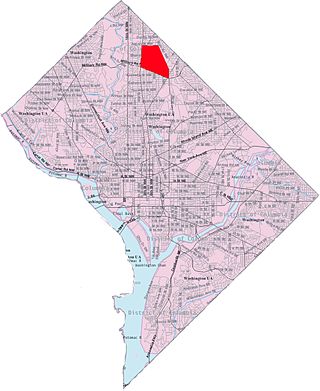
Manor Park is a neighborhood in Ward 4 of northwest Washington, D.C.
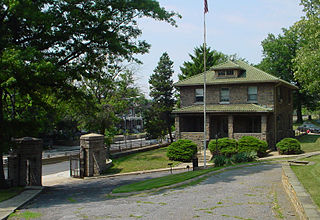
Prospect Hill Cemetery, also known as the German Cemetery, is a historic German-American cemetery founded in 1858 and located at 2201 North Capitol Street in Washington, D.C. From 1886 to 1895, the Prospect Hill Cemetery board of directors battled a rival organization which illegally attempted to take title to the grounds and sell a portion of them as building lots. From 1886 to 1898, the cemetery also engaged in a struggle against the District of Columbia and the United States Congress, which wanted construct a main road through the center of the cemetery. This led to the passage of an Act of Congress, the declaration of a federal law to be unconstitutional, the passage of a second Act of Congress, a second major court battle, and the declaration by the courts that the city's eminent domain procedures were unconstitutional. North Capitol Street was built, and the cemetery compensated fairly for its property.

Washington, D.C., is administratively divided into four geographical quadrants of unequal size, each delineated by their ordinal directions from the medallion located in the Crypt under the Rotunda of the Capitol. Street and number addressing, centered on the Capitol, radiates out into each of the quadrants, producing a number of intersections of identically named cross-streets in each quadrant. Originally, the District of Columbia was a near-perfect square but contained more than one settlement; the Capitol was to be the center of the City of Washington. Thus, the Capitol was never located at the geographic center of the whole territory, which was eventually north of the Potomac River, consolidated into one city. As a result, the quadrants are of greatly varying size. Northwest is quite large, encompassing over a third of the city's geographical area, while Southwest is little more than a few neighborhoods, large parks, and a military base.
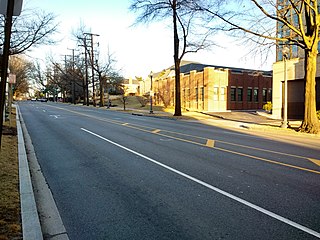
Western Avenue is one of three boundary streets between Washington, D.C., and the state of Maryland. It follows a southwest-to-northeast line, beginning at Westmoreland Circle in the south and ending at Oregon Avenue NW in the north. It is roughly 3.5 miles (5.6 km) in length. First proposed in 1893, it was constructed somewhat fitfully from about 1900 to 1931.
Julius Germuiller, also spelled Julius Germüller, was a German-American architect from Washington, D.C. Throughout his 44-year career, he designed hundreds of buildings, mostly row houses. His work included designs in every quadrant of the city and a large number of his buildings are still extant. One of his works is listed on the National Register of Historic Places (NRHP).

Finley General Hospital was a Union Army hospital which operated near Washington, D.C., during the Civil War. It operated from 1862 to 1865.

Harewood General Hospital was one of several purpose-built pavilion style hospitals operating in the Washington, D.C., area during the Civil War which rendered care to Union military personnel. A purpose-built pavilion style hospital, it was in use from September 4, 1862, to May 5, 1866.

